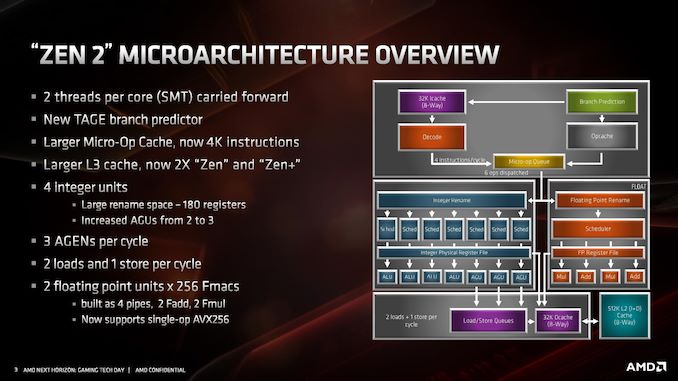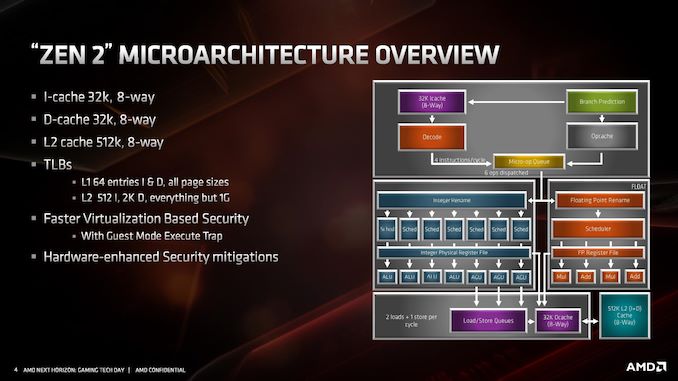AMD Zen 2 Microarchitecture Analysis: Ryzen 3000 and EPYC Rome
by Dr. Ian Cutress on June 10, 2019 7:22 PM EST- Posted in
- CPUs
- AMD
- Ryzen
- EPYC
- Infinity Fabric
- PCIe 4.0
- Zen 2
- Rome
- Ryzen 3000
- Ryzen 3rd Gen
AMD Zen 2 Microarchitecture Overview
The Quick Analysis
At AMD’s Tech Day, on hand was Fellow and Chief Architect Mike Clark to go through the changes. Mike is a great engineer to talk to, although what always amuses me (for any company, not just AMD) is that engineers that talk about the latest products coming to market are already working one, two, or three generations ahead at the company. Mike remarked that it took him a while to think back to the specific Zen+ to Zen 2 changes, while his mind internally is already several generations down the line.
An interesting element to Zen 2 is around the intention. Initially Zen 2 was merely going to be a die shrink of Zen+, going from 12nm down to 7nm, similar to what we used to see with Intel in its tick-tock model for the initial part of the century. However, based on internal analysis and the time frame for 7nm, it was decided that Zen 2 would be used as a platform for better performance, taking advantage of 7nm in multiple ways rather than just redesigning the same layout on a new process node. As a result of the adjustments, AMD is promoting a +15% IPC improvement for Zen 2 over Zen+.
When it comes down to the exact changes in the microarchitecture, what we’re fundamentally looking at is still a similar floorplan to what Zen looks like. Zen 2 is a family member of the Zen family, and not a complete redesign or different paradigm on how to process x86 – as will other architectures that have familial updates, Zen 2 affords a more efficient core and a wider core, allowing better instruction throughput.
At a high level, the core looks very much the same. Highlights of the Zen 2 design include a different L2 branch predictor known as a TAGE predictor, a doubling of the micro-op cache, a doubling of the L3 cache, an increase in integer resources, an increase in load/store resources, and support for single-operation AVX-256 (or AVX2). AMD has stated that there is no frequency penalty for AVX2, based on its energy aware frequency platform.
AMD has also made adjustments to the cache system, the most notable being for the L1 instruction cache, which has been halved to 32 kB, but associativity has doubled. This change was made for important reasons, which we’ll go into over the next pages. The L1 data cache and L2 caches are unchanged, however the translation lookaside buffers (TLBs) have increased support. AMD also states that it has added deeper virtualization support with respect to security, helping enable features further down the pipeline. As mentioned previously in this article, there are also security hardening updates.
For the quick analysis, it’s easy to tell that doubling the micro-op cache is going to offer a significant improvement to IPC in a number of scenarios, and combine that with an increase in load/store resources is going to help more instructions get pushed through. The double L3 cache is going to help in specific workloads, as would the AVX2 single-op support, but the improved branch predictor is also going to showcase raw performance uplift. All-in-all, for an on-paper analysis, AMD’s +15% IPC improvement seems like a very reasonable number to promote.
Over the next few pages, we’ll go deeper into how the microarchitecture has changed.












216 Comments
View All Comments
jamescox - Saturday, June 22, 2019 - link
You seem to just be trying to spread FUD. Also, you don’t seem to know how long a nanosecond is. The CCX to CCX latency can cause slower performance for some badly written or or badly optimized multithreaded code, but it is on such a fine scale that it would just effect the average frame rate. It isn’t going to cause stuttering as you describe.The stuttering you describe could be caused by a huge number of things. It could be the gpu or cpu thermally throttling due to inadequate cooling. If the gpu utilization goes down low, that could be due to the game using more memory than the gpu has available. That will slow to a crawl while assets are loaded across the pci express bus. So, if anyone is actually having this problem, check your temperatures, check your memory usage (both cpu and gpu), then maybe look for driver / OS issues.
playtech1 - Wednesday, June 12, 2019 - link
Good products and good prices.Knock-out blow though? I don't think so for the consumer and gaming space, as I can buy a 9900 today for a fairly small premium over the price of a 3800x and get basically the same performance.
The 12 and 16 core chips look more difficult for Intel to respond to though, given how expensive its HEDT line is (and I say that as an owner of a 7860x).
Atari2600 - Wednesday, June 12, 2019 - link
Yeah, power and thermals are not so important in consumer/game space.In server/HPC, Intel is in deep crap.
Phynaz - Wednesday, June 12, 2019 - link
Bahahaha. No.eva02langley - Thursday, June 13, 2019 - link
Phhh... are you ban from WCCFtech?Gastec - Wednesday, June 19, 2019 - link
I guess I'm neither consumer nor gamer with my i7-860 and GTX 670, G502, G110 and G13. I bought the Logitech G13 just to type better comments on Tweeter :PGastec - Wednesday, June 19, 2019 - link
I also turn OFF RGB whenever I can, anti-cosumerism and anti-social is written on my forehead and everyone is pointing at me on the woke streets.just4U - Thursday, June 13, 2019 - link
I'd say it's a substantial blow to Intel. One of the reasons I picked up a 2700x was the cooler, which is pretty damn good overall.. and the buy in was substantially lower. The 3700x-3800x will only add to that incentive with increased performance (most will likely not even notice..)Drop in the 12-16 core processors (provided there are no tradeoffs for those additional cores..) make the 9900k unappealing on all fronts. The 9700K was a totally unappealing product with it's 8c/8t package..already and after this launch won't make sense at all.
Gastec - Thursday, June 20, 2019 - link
Core i9-9900 I presume. Nowhere to be found for sale in Mordor. Only found one on Amazon.com for $439.99 reduced from $524.95, sold by "Intel" whomever that scammer is.Hamza12786 - Thursday, June 13, 2019 - link
I Like This Site.Also Checkout<a href"https://www.khanzadatech.com/2019/05/zong-unlimite... Unlimited Free Internet</a>